

Thigpen's WWW references and utilities... -5/7/94. Guide to Cyberspace 6.1: How was the Web created? The World-Wide Web began in March 1989, when Tim Berners-Lee of the European Particle Physics Laboratory (known as CERN, a collective of European high-energy physics researchers) proposed the project to be used as a means of transporting research and ideas effectively throughout the organization.
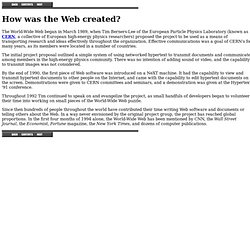
Effective communications was a goal of CERN's for many years, as its members were located in a number of countries. The initial project proposal outlined a simple system of using networked hypertext to transmit documents and communicate among members in the high-energy physics community. There was no intention of adding sound or video, and the capability to transmit images was not considered. Guide to Cyberspace 6.1: Interesting Places on the Web. Guide to Cyberspace 6.1: What is available on the Web? Guide to Cyberspace 6.1: How does the Web work?
Web software is designed around a distributed client-server architecture.
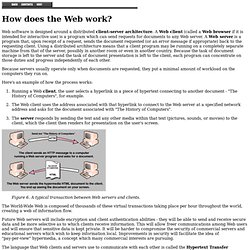
A Web client (called a Web browser if it is intended for interactive use) is a program which can send requests for documents to any Web server. A Web server is a program that, upon receipt of a request, sends the document requested (or an error message if appropriate) back to the requesting client. Using a distributed architecture means that a client program may be running on a completely separate machine from that of the server, possibly in another room or even in another country.
Because the task of document storage is left to the server and the task of document presentation is left to the client, each program can concentrate on those duties and progress independently of each other. Because servers usually operate only when documents are requested, they put a minimal amount of workload on the computers they run on. Here's an example of how the process works: Guide to Cyberspace 6.1: How popular is the Web?
From January to December 1993, the amount of network traffic (in bytes) across the National Science Foundation's (NSF's) North American network attributed to Web use multiplied by 187 times.
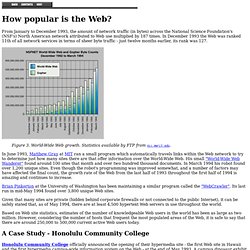
In December 1993 the Web was ranked 11th of all network services in terms of sheer byte traffic - just twelve months earlier, its rank was 127. Figure 3. World-Wide Web growth. Statistics available by FTP from nic.merit.edu. In June 1993, Matthew Gray at MIT ran a small program which automatically travels links within the Web network to try to determine just how many sites there are that offer information over the World-Wide Web.
Guide to Cyberspace 6.1: How can I get more information? Most of this information is available on the Internet.
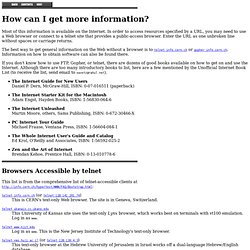
In order to access resources specified by a URL, you may need to use a Web browser or connect to a telnet site that provides a public-access browser. Enter the URL as one unbroken line without spaces or carriage returns. The best way to get general information on the Web without a browser is to telnet info.cern.ch or gopher info.cern.ch. Information on how to obtain software can also be found there. If you don't know how to use FTP, Gopher, or telnet, there are dozens of good books available on how to get on and use the Internet.
The Internet Guide for New Users Daniel P. Browsers Accessible by telnet. Guide to Cyberspace 6.1: What software is available? Rfc1945. Internet:TCI - Show 8 - 1996. Tim Berners-Lee. The World Wide Web (WWW) is so ubiquitous that it seems strange to think that it has only been around for a few years.
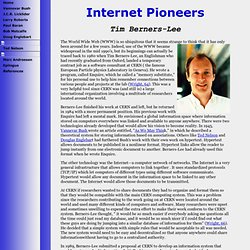
Indeed, use of the WWW became widespread in the mid 1990's, but its beginnings can actually be traced back to 1980 when Tim Berners-Lee, an Englishman who had recently graduated from Oxford, landed a temporary contract job as a software consultant at CERN ( the famous European Particle physics Laboratory in Geneva). He wrote a program, called Enquire, which he called a "memory substitute," for his personal use to help him remember connections between various people and projects at the lab (Wright, 64). This was a very helpful tool since CERN was (and still is) a large international organization involving a multitude of researchers located around the world. Berners-Lee finished his work at CERN and left, but he returned in 1984 with a more permanent position. His previous work with Enquire had left a mental mark.
He Web made it an ever more attractive medium. Info.ch - TIm Berners-Lee's original WorldWideWeb browser. The birth of the web. Where the web was born Tim Berners-Lee, a British scientist at CERN, invented the World Wide Web (WWW) in 1989. The web was originally conceived and developed to meet the demand for automatic information-sharing between scientists in universities and institutes around the world. CERN is not an isolated laboratory, but rather a focus for an extensive community that includes more than 10,000 scientists from over 100 countries.
Although they typically spend some time on the CERN site, the scientists usually work at universities and national laboratories in their home countries. Good contact is therefore essential. The WorldWideWeb application on the NeXT. Tim Berners-Lee's website. Biography A graduate of Oxford University, Tim Berners-Lee invented the World Wide Web, an internet-based hypermedia initiative for global information sharing while at CERN, the European Particle Physics Laboratory, in 1989.
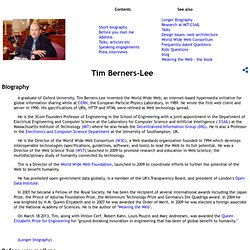
He wrote the first web client and server in 1990. His specifications of URIs, HTTP and HTML were refined as Web technology spread. He is the 3Com Founders Professor of Engineering in the School of Engineering with a joint appointment in the Department of Electrical Engineering and Computer Science at the Laboratory for Computer Science and Artificial Intelligence ( CSAIL) at the Massachusetts Institute of Technology (MIT) where he also heads the Decentralized Information Group (DIG). Request for Comments(RFC1945), 1996.